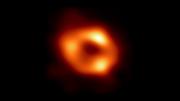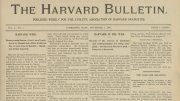More than 300 scientists worldwide, working collaboratively, have created an extraordinary image of the black hole at the center of the Milky Way Galaxy. Sagittarius A*, a supermassive black hole, is just 25,000 light-years (more than 147 trillion miles) from Earth, much closer than Messier 87* (M87*), the first black hole whose image, when published in April 2019, made headlines around the world.
Though smaller than M87*, the black hole at the center of the Milky Way Galaxy occupies about the same amount of the sky because it is much closer to Earth, explains Pellegrino University Professor Peter Galison. (In the same way, the moon appears to observers on Earth to be about the same size as the far more massive sun, as anyone who has experienced a full eclipse has seen.) “M87* is 20 billion miles across,” Galison says, “about three times the size of our solar system. Big compared to Earth, but because it’s 55 million light-years away, it’s like seeing a grain of sand in Los Angeles from Boston.”
Sagittarius A*, though just 15 million miles across, is close enough to Earth that astronomers can actually see stars orbiting around it. In fact, two astronomers, Reinhard Genzel and Andrea Ghez, who won the 2020 Nobel Prize in physics, “were able to see these stars going around incredibly fast,” says Galison, “on 15-year orbits. Many planets orbit the sun slower than that. For an astronomer to see a star being pulled around like that is amazing.”
Despite its relative proximity to Earth, creating the image of Sagittarius A* that was published today required a telescope the size of the planet. Fortunately, says Galison, “we live in a golden age of observational astronomy.” Data gathered from eight telescopes at six separate sites around the globe, all part of the Event Horizon Telescope (EHT), were combined to create the image, which shows a donut-shaped ring of dense, hot gas, emitting energy. In its center is a shadow, where the black hole’s intense gravitational pull prevents even light from escaping. Numerous Harvard scientists were involved in gathering the data and creating the image, including founding director of the EHT Sheperd “Shep” Doeleman, now working on a next-generation version of the EHT that will be able to image black holes that are smaller or farther away than the current technology permits.
Black holes, which were considered mostly theoretical just decades ago, now appear to exist at the center of every galaxy, and to affect their structure. They are “among the most mysterious and fascinating objects in astronomy,” says Galison, who is one of the founders of Harvard’s Black Hole Initiative, which was launched in the spring of 2016, a few months after scientists first detected the gravitational waves emitted when two black holes collided. “They interest observational astronomers and astrophysicists, as well as mathematicians and philosophers,” he adds. “Inside a black hole, an object can theoretically encounter its own earlier self, by going backwards in time.” And their mass and density raise gravitational forces to a level that creates a feature known as an “event horizon,” a point beyond which nothing can escape, so that knowledge itself appears to end. “They seem to be the most extraordinarily generative, endlessly fascinating objects that one can think of.”
Ten papers about the image of Sagittarius A*, and how it was made, were released as part of this morning’s announcement. In the image, a narrow “photon ring” of light encircles the black hole’s event horizon. The full-width donut of light originates from the black hole’s accretion disc, formed by the energy emitted as matter rushes toward the event horizon. Because the black hole is spinning at a speed approaching the speed of light, parts of the donut (those moving toward Earth) appear brighter than ones spinning away, due to the Doppler effect. Astronomers added color to the image because the wavelengths of light they gathered are not visible to the human eye.
The importance of the event, from Galison’s perspective, is that it marks the beginning of a census of black holes. “Just as, by studying many stars, you could understand how stars are formed, mature, run out of fuel, collapse, and explode, you need a kind of demographics to understand black holes. There are 100 billion galaxies in the visible universe, each with a supermassive black hole at its center,” which he says, “is amazing. We didn’t even know about black holes several decades ago. And now we see that they are fundamental features of galaxies themselves.”

The Event Horizon Telescope (EHT) Collaboration created the single image (top frame) of the black hole by averaging together thousands of images. This averaged image retains features more commonly seen in the varied images, and suppresses features that appear infrequently. The complete set of images can be clustered into four groups based on similar features. An averaged, representative image for each of the four clusters is shown in the bottom row. Three of the clusters show a ring structure, but with differently distributed brightness around the ring. The fourth cluster contains images that also fit the data but do not appear ring-like. The bar graphs show the relative number of images belonging to each cluster. Thousands of images fell into each of the first three clusters, while the fourth and smallest cluster contains only hundreds of images. The heights of the bars indicate the relative "weights," or contributions, of each cluster to the averaged image at top.
IMAGE CREDIT: EHT Collaboration









